The Modulation Instability Analysis and Analytical Solutions of the Nonlinear Gross−Pitaevskii Model with Conformable Operator and Riemann Wave Equations via Recently Developed Scheme
Abstract
In this manuscript, we focus on the application of recently developed analytical scheme, namely, the rational sine-Gordon expansion method (SGEM). Some new exact solutions of Riemann wave system and the nonlinear Gross−Pitaevskii equation (GPE) by using this method are extracted. This method is based on the general properties of the SGEM which uses the fundamental properties of trigonometric functions. Many novel analytical solutions such as dark, bright, mixed dark–bright, hyperbolic, and periodic wave solutions are successfully extracted. Physical meanings of solutions are simulated by the various figures in 2D and 3D along with the contour graphs. Strain conditions of the existence are also reported in detail. Finally, modulation instability analysis of the nonlinear GPE is studied in detail.
1. Introduction
In modern century, the real-world problems arising in various fields of daily life, particularly, engineering such as computer viruses, cyber security, artificial intelligence, magnetism, physics, oceanography, and so on have been symbolized via mathematical norms. Scientists have investigated their connections among multidisciplinary properties. For the last several decades, newly developed mathematical properties have been used to explain many physical problems [1–5]. In [6], scientists have applied the Hopf Bifurcation theorem on the models arising in the group competitive martial arts. In [7], the modified double Laplace transform method is handled to extract some results of the pseudo-hyperbolic telegraph model. The relativistic wave equation associated with the Schrödinger equation was studied in terms of traveling wave distribution in [8]. Wazwaz [9, 10] introduced the several optical solitons for (2 + 1)-dimensional Schrödinger (NLS) equation. In [11], modified exponential function method have been applied to the nonlinear Gerdjikov–Ivanov equation with the M-fractional. Hu et al. [12] focused on the rational and semirational properties of B-type Kadomtsev Petviashvili Boussinesq model. Kudryashov [13] presented the Lax pair and the first integrals for some mathematical properties. Ghanbari et al. [14] observed the rational function solutions for the extended Zakharov Kuzetsov equation. M-type dark soliton facts in optical fibers have been investigated by Yao et al. [15]. Hybrid method has been applied into Rosenau–Hyman equation [16]. Real quadratic fields have been focused on the Handy method in [17]. Generalized (3 + 1) Shallow Water-Like (SWL) equation was observed by Dusunceli [18]. The perturbed Schrödinger and the Heisenberg ferromagnetic spin chain have been investigated in [19, 20]. Park et al. [21] have observed the fifth-order Korteweg-de Vries equations. The multiple exp-function method has been applied on some mathematical models [22]. Chebyshev series have been used to investigate numerically the integro-differential equations in [23]. Duffing and diffusion reaction models have been investigated in the M-derivative operator in [24]. W-shape properties of the (3 + 1)-dimensional nonlinear evolution equations have been reported in [25]. The general and wide-spectral explicit properties of the complex coupled Maccari system have been introduced in [26]. The superconductivity models have been studied in [27]. The Benjamin–Bona–Mahony–Peregrine equation with power law nonlinearity has been studied in [28]. The finite element method have been used to observe a surface plasmon resonance (SPR) sensor in [29]. A current decoupling control strategy was considered on combining a fast terminal sliding mode control and an adaptive extended state observer [30]. A Robust Hammerstein–Wiener Model identification method was applied in [31]. A robust model predictive current control scheme was proposed in [32]. Liu and Liu [32] have studied on the photoacoustic microfluidic pumps [33]. A linear AC unit commitment formulation have been presented in [34]. Moreover, seismic-wave attenuation, shear-wave attenuations, and waves with a wide range of frequencies in digital core have been introduced [35–38]. Some control problems and optimization application have been presented [39–45]. In [46], bipolar cubic fuzzy graphs have been studied. The shallow ocean-waves and rogue waves with translational coordination have been observed in [47, 48]. The influence of Woods–Saxon potential was presented in [49]. Soliton, numerical, and closed solutions of nonlinear models have been investigated by using various schemes [49–56]. To represent the wave’s amplitude, simplest equation algorithms have been used by Inc et al. [57]. Az-Zo’bi et al. [58] studied and used to observe the pulses propagation with power nonlinearity via conformable. Some novel liquid crystals models have been investigated by using some analytical schemes in [59]. Ur Rahman et al. [60] extracted the deeper properties of the fractional regularized long-wave Burgers problem by using two different fractional operators, Beta and M-truncated. In [61], the fractional Huxley equation with Beta and M-truncated derivatives have been considered for reporting nonlinear coherent structures arising in a variety of environments, like spectrum energy, applied mathematics, mechanics, control theory, biology, seismology, and many more.
The paper is organized as follows. In Section 2, the rational sine-Gordon expansion method (RSGEM) is given in detail. In Section 3, RSGEM is applied to extract the stationary optical solitons, mixed dark, and bright solitons to the Equations (1) and (4). Additionally, stability properties of the complex mixed dark–bright soliton solutions are also reported. Finally, the paper is completed by presenting the important novelties of this paper in Section 4.
2. General Properties of RSGEM
3. Applications of Projected Scheme
In this part of the paper, the stationary soliton and new analytical solutions to the Riemann wave system and conformable GPE is studied by using RSGEM.
3.1. RSGEM to the Riemann Wave System of Equations
Substituting Equation (18) and its second derivative into Equation (16), we obtain an equation of sini(w)cosi(w). Getting all coefficients of these terms to zero, we gain a system of equations. Solving this system produces the values of parameters Ai, Bi, c1, d1, μ, ω, and δ which results in many entirely new traveling wave solutions to the Equation (1).

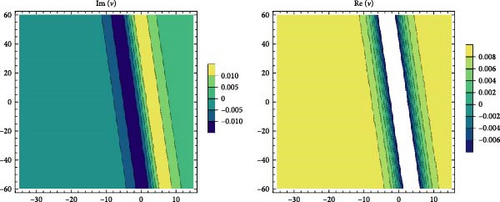
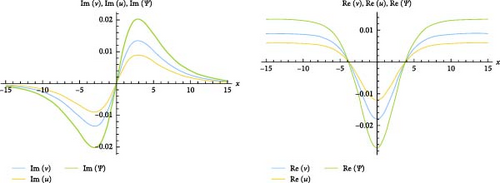

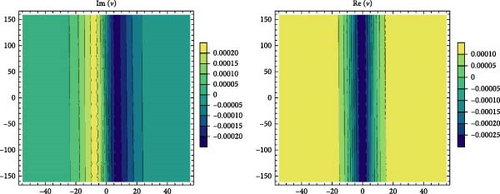
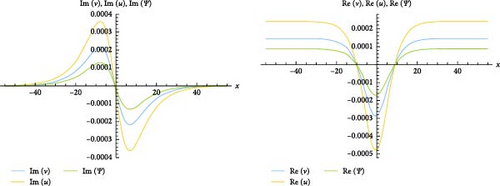
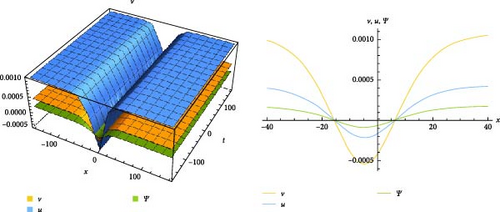
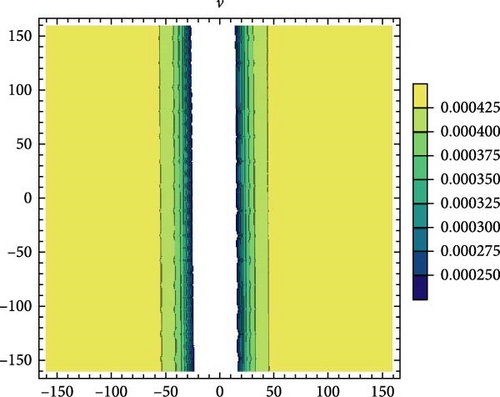
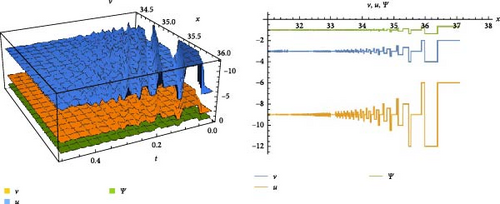

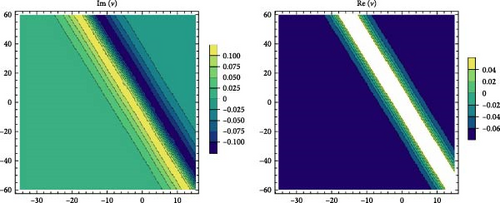

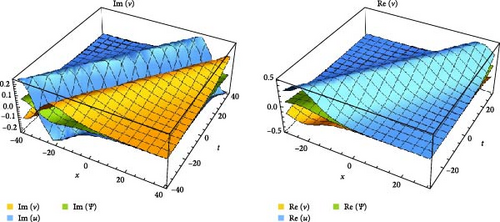
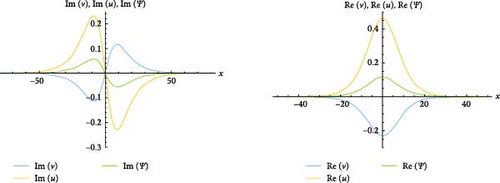
3.2. RSGEM for the Nonlinear GPE in Conformable Operator
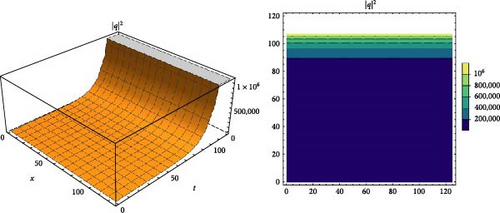
3.3. Stability Properties of q1(X, T)
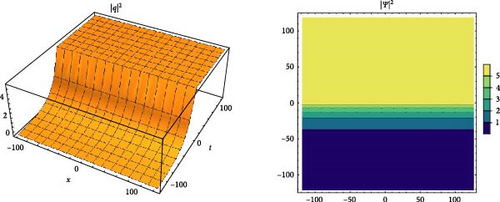
3.4. Stability Properties of q2(X, T)
4. Modulation Instability Analysis of the Nonlinear GPE
We have the following cases
We have the following subcases
These subcases can be expressed in Figure 17 between −10 < α < 10.

5. Conclusions
In this work, we introduced a recently developed scheme being RSGEM. RSGEM has been handled to the Riemann wave system and nonlinear GPE in conformable frame. Main novelty of this paper is the solutions such as complex, mixed dark–bright, and hyperbolic in conformable operator were extracted. Via graphical illustrations, the dynamical behaviors of solutions found have been reported. The stability properties of the obtained solutions have been introduced, as well. Moreover, the strain conditions of solutions for valid have been also given.
It is estimated that these dark solitons may be closely related to the gravitational dynamical potential [73]. MI analysis of the nonlinear Gross–Pitaevskii equation has been studied, as well. Its various wave simulations have been also plotted in Figure 17. From these results, it may be suggested that the RSGEM is a power tool to solve such nonlinear partial models arising in applied and engineering sciences. Therefore, it may be also applied to investigate deeper properties of some real-world problems [74–77].
As the future direction of this topic, it is envisaged and suggested that some important analytical schemes will be developed by the experts studying in these areas of nonlinear sciences to solve more complex PDEs. This comes from the properties of real-world problems.
Conflicts of Interest
The authors declare that they have no known conflicts of interest.
Authors’ Contributions
W. Gao majorly contributed and H.M. Baskonus contributed on typing collection and formal analyzing.
Open Research
Data Availability
The data that support the findings of this study are available within the article.




